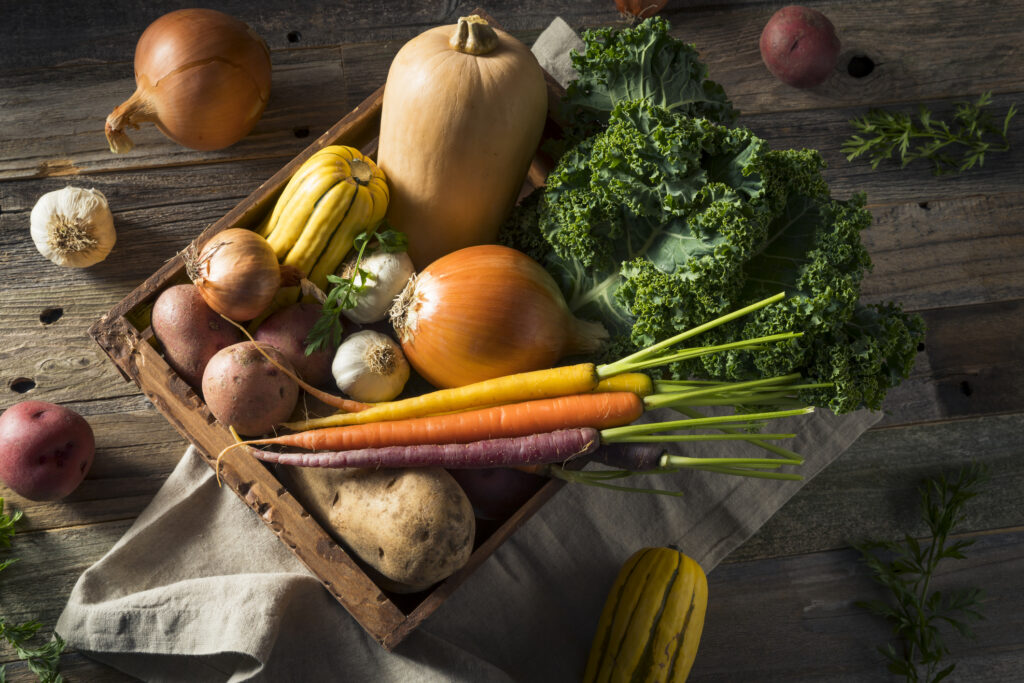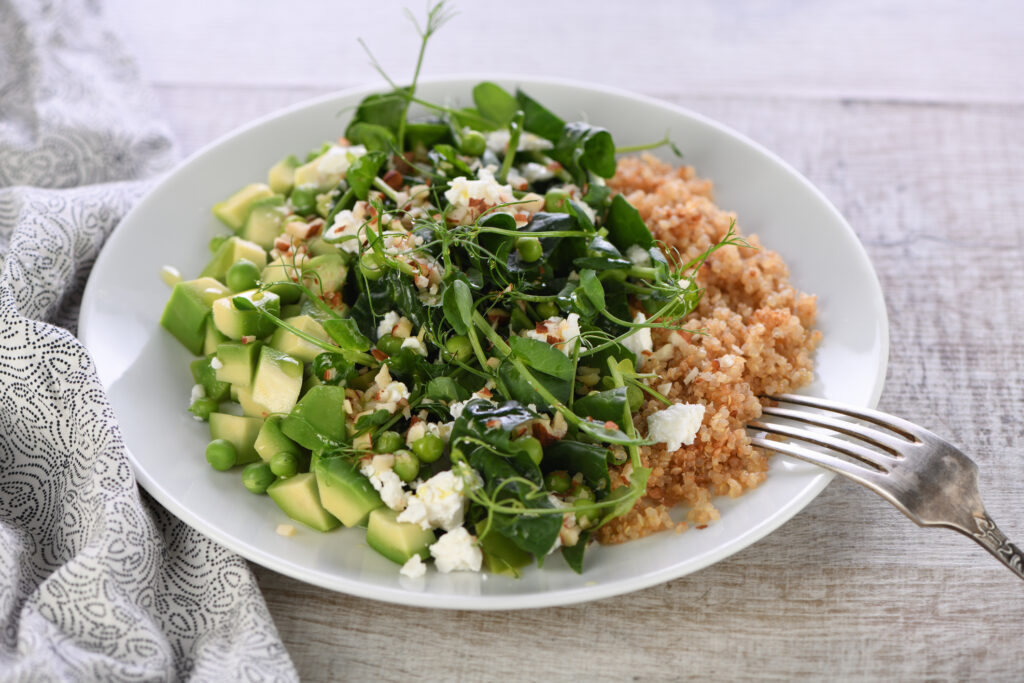
Seasonal eating is beneficial for our health as well as the health of the planet. Fresh produce that has recently been harvested, and hasn’t had to travel for thousands of miles, is typically fresher, tastier and much more nutritionally dense.
Although fruits do not begin to ripen until the summer in the UK, spring brings with it an abundance of fresh vegetables. By integrating these fresh veggies into daily meals, we are embracing the natural rhythm of the seasons whilst supporting local agriculture and nourishing our bodies.
Embracing the spring harvest

With their crisp textures, vibrant colours and delicate flavours, spring vegetables offer the perfect opportunity to breathe new life into your cooking. From fresh asparagus and purple sprouting broccoli to tart rhubarb, there’s a mouth-watering array of seasonal delights to uncover. During this time of celebration and renewal, it’s the ideal time to hold a picnic with family and friends or just enjoy a bit of al fresco dining in the garden.
Familiarise yourself with what’s in season in your region to make the most of the available produce. Local independent health food stores like Real Foods are good places to shop for seasonal produce. Not only will you be supporting a local business, but you’ll also discover unique varieties and flavours you may not find in supermarkets.
When you are planning your meals, try to base them around what’s in season. Get creative in the kitchen by experimenting with new recipes, flavour combinations, and cooking techniques to make the most of seasonal eating for spring. Whether you’re whipping up some grilled asparagus or baking a rhubarb pie, let your choices be guided by the seasons.

Supporting local farmers and reducing food miles
Eating seasonally is not just better for your health but better for the planet too. Choosing seasonal produce helps to reduce carbon emissions because it reduces the need for energy-intensive practices like greenhouse growing or long-distance transportation. Eating seasonally also helps to support local farmers, which contributes to the preservation of farmland and promotes biodiversity.
Another bonus to seasonal eating is that it helps to reduce food waste. Eating fresh produce when it is at its peak for ripeness means that fewer fruits and veggies are spoiled and thrown away. Food waste is a major contributor to greenhouse gas emissions. This is because decomposing organic waste matter releases methane, a greenhouse gas, into the atmosphere.
Spring’s palette: A showcase of seasonal produce
During the spring months, from March to May, there is an abundance of nutritious vegetables available. Here’s a selection of what’s in season at this time:
Asparagus
Whether you roast it, grill it or sauté it, asparagus really is the quintessential spring vegetable. Highly versatile, it can be added to salads, soups, risottos, pasta dishes, and quiches. Full of nutrients, asparagus is a rich source of vitamins A and K, which help to promote healthy skin and bones. When shopping for this vegetable, look for bright green spears with tight tips. Asparagus can tend to go off quickly, so a top tip is to trim the ends and put the stalks end down in a jar of water in the fridge. It will keep like this for up to three days.
Leafy greens
Leafy greens such as spinach and kale are abundant during springtime. Both of these green veggies are nutrient powerhouses and work well in smoothies and juices as a nutrition boost. Kale is bursting with vitamins A, B6, C and K, as well as folate and fibre, while spinach is an excellent source of vitamins A and K, as well as iron. Team these leafy greens with one of the many varieties of lettuce that are in season during spring for a crisp and nutritious salad base.

Cruciferous vegetables
Cabbage, broccoli and cauliflower are just some of the cruciferous vegetables that are in season during spring. Not only are they a rich source of vitamins C, E and K, plus folate and fibre, but they have been shown to have cancer-fighting properties. These nutritious veggies work well in soups, so what better excuse is there to get out your stick blender and whizz up a batch?
Peas
A member of the legume family, peas are often a popular feature of springtime recipes. They inject a burst of sweetness and vibrant colour to salads, stir-fries and risottos. The simplest way to cook them is by lightly steaming them and tossing them with mint and lemon zest for a refreshing side dish. Peas are a good source of the carotenoids lutein and zeaxanthin, which support eye health. They are also high in fibre and are packed with antioxidants.
Artichokes
Although they are often referred to as a vegetable, artichokes are in fact a type of thistle. With their earthy flavour and meaty texture, they work well when steamed whole and served with aioli or added to pasta dishes and grain bowls. The hearts can be marinated and grilled or added to creamy dips. Artichokes are a good source of fibre, antioxidants, folate and vitamin C.
Wild garlic
With its vibrant green leaves and pungent aroma, wild garlic is a sought-after springtime ingredient that offers a host of health benefits. It has antibacterial and antifungal properties, is rich in antioxidants, and is a good source of vitamins and minerals. Wild garlic works particularly well in pestos, soups and stews, salads, omelets and quiches.
Root vegetables
Root veggies such as carrots, beetroots and radishes add a wonderful splash of colour to meals. They work particularly well when roasted in some olive oil with fresh oregano and a pinch of salt. Root vegetables are a good source of antioxidants and fibre. Carrots are particularly rich in beta-carotene, which is turned into vitamin A in the body. Beetroots contain nitrates, which may help to lower blood pressure. Famed for their peppery bite, radishes are a flavourful addition to spring salads and are a good source of vitamin C and coenzyme Q10.

Rhubarb
Technically speaking, rhubarb is actually a vegetable, but it is officially classed as a fruit. This spring classic works well in pies and crumbles, but often needs the addition of sugar to tone down its sour, tart taste. Rich in antioxidants, vitamin K and fibre, rhubarb is also a good source of anthocyanins and proanthocyanidins. These antioxidants help to protect the body against health-related issues such as cancer, heart disease and diabetes.
Spring in the kitchen: Creative and nutritious recipe ideas for seasonal eating
Experiment with recipes that showcase the unique flavours of spring produce. Incorporate fresh greens into salads, roast spring vegetables for flavourful side dishes, and use herbs to add brightness to your dishes.
Try our Vegetarian Spring Vegetable Risotto, which is full of vibrantly coloured and crunchy vegetables. It’s beautifully flavoured with wild garlic and other seasonal herbs. Another twist on the spring risotto is
this recipe, which makes use of those super-healthy cruciferous veggies.

A delicious and nutrient-packed lunch option is this Purple Sprouting Broccoli, Pesto and Cherry Tomato Salad. If you’d like to try making your own pesto, then check out this recipe. It’s a great excuse to try your hand at foraging for wild herbs!
The good thing about spring vegetables is that they make highly nutritious and detoxifying meals, which will be kind to your digestive system. This Pea, Asparagus and Avocado Spring Salad is packed with nutritious green veggies and healthy fats, making for an ideal detoxifying lunch.
Another super healthy spring recipe is our Wild Greens with Ashwagandha Dressing. This one makes the most of all those lovely green leaves that have just started to grow. Our Quinoa, Avocado and Pea Salad is another delicious, detoxifying lunch idea that’s full of spring veggies. You might want to add some additional broad beans or radishes for some extra bite and colour. Finally, this Strawberry, Watercress and Hazelnut Salad makes use of one of the first fruits to ripen at the end of spring and beginning of summer. The balsamic vinegar really lifts the flavour!

Continuing the journey through seasonal eating
We hope this has piqued your interest in seasonal eating, and perhaps inspired you to make the most of the wonderful spring produce that is available. By embracing seasonal eating during spring, you not only nourish your body with fresh, nutritious foods but also cultivate a deeper connection to the rhythms of the seasons. So, why not get creative in the kitchen and enjoy the flavours of all that spring has to offer?







